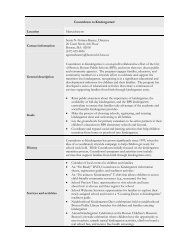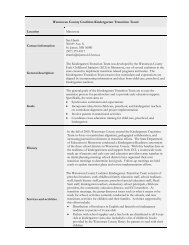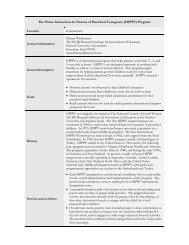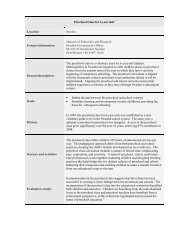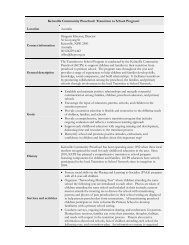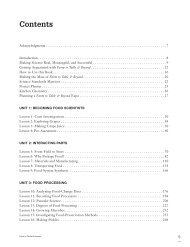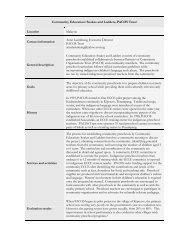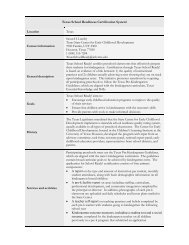Proceedings of the Fourth Annual Teachers College Educational ...
Proceedings of the Fourth Annual Teachers College Educational ...
Proceedings of the Fourth Annual Teachers College Educational ...
Create successful ePaper yourself
Turn your PDF publications into a flip-book with our unique Google optimized e-Paper software.
Investigating <strong>the</strong> Effects <strong>of</strong> Choice and Feedback as Learning<br />
Mechanics in an <strong>Educational</strong> Game<br />
Pantiphar Chantes, Apichai Chaiwinij, Nilgun Gunbas, Tatyana Dvorkin, Daniel L. H<strong>of</strong>fman,<br />
Selen Turkay, <strong>Teachers</strong> <strong>College</strong>, Columbia University, 525 W. 120 th Street, New York, NY<br />
Email: pdc2114@columbia.edu, ac3344@tc.columbia.edu, ng2248@columbia.edu,<br />
td2347@tc.columbia.edu, dlh2109@columbia.edu, st2282@columbia.edu<br />
Abstract: The current study set out to examine <strong>the</strong> impact <strong>of</strong> learning and assessment<br />
mechanics in various conditions on an existing educational game. The result was multiple<br />
versions <strong>of</strong> <strong>the</strong> game, built on identical game mechanics, but with different learning and<br />
assessment variables. The impact <strong>of</strong> <strong>the</strong>se variables was subsequently analyzed to<br />
determine <strong>the</strong>ir impact on three dependent variables: learning, motivation, and in-game<br />
performance. One hundred thirty-eight (N=138) sixth grade students were randomly<br />
assigned to play one <strong>of</strong> <strong>the</strong> four versions <strong>of</strong> <strong>the</strong> game. After only thirty minutes <strong>of</strong> play,<br />
results suggest that providing players with a choice <strong>of</strong> non-player character from whom to<br />
receive feedback results in significantly higher learning outcomes and desire to continue<br />
playing compared to a non-choice condition. Comparisons between informative and<br />
elaborative feedback; however, did not influence student learning, motivation, or in-game<br />
performance.<br />
Good educational video games possess <strong>the</strong> powerful features for engaging, learning, and sustaining<br />
interest, which involves doable challenges, clear goals, freedom <strong>of</strong> choices, and relevant feedback.<br />
However, many games intended to educate, currently lack coherent connections to <strong>the</strong>ories <strong>of</strong> learning or<br />
fundamental bodies <strong>of</strong> research (Shaffer, Squire, Halverson, & Gee, 2005). This gap between <strong>the</strong>ory and<br />
practice has resulted in video games that may be enjoyable, but do not support academic learning<br />
(Barab, Thomas, Dodge, Carteaux, & Tuzun, 2005). In order to reverse this phenomenon, <strong>the</strong> Games for<br />
Learning Institute (G4LI) has urged educational game designers to consider in <strong>the</strong>ir designs three<br />
categories <strong>of</strong> mechanics: game, learning, and assessment (Plass et al., in press; Plass, Homer, Kinzer,<br />
Frye, & Perlin, 2011a).<br />
Game mechanics is conceivably <strong>the</strong> most familiar concept to game designers and much has been written<br />
on <strong>the</strong> topic (see Bjork & Holopainen, 2005; Fullerton, Swain, & H<strong>of</strong>fman, 2008; Salen & Zimmerman,<br />
2004). Common game mechanics include leveling, movement, and turn taking. For <strong>the</strong> purposes <strong>of</strong> this<br />
study, game mechanics describe <strong>the</strong> essential game play activity and are distinct from learning<br />
mechanics and assessment mechanics. Learning mechanics are grounded in learning <strong>the</strong>ory and<br />
describe specialized activities that have learning as <strong>the</strong>ir primary objective, whereas assessment<br />
mechanics are grounded in test <strong>the</strong>ory and are specialized activities that have assessment as <strong>the</strong>ir<br />
primary objective.<br />
The current study set out to examine <strong>the</strong> impact <strong>of</strong> <strong>the</strong>se learning and assessment mechanics on three<br />
dependent variables: learning, motivation, and in-game performance. The overarching question was if<br />
and how <strong>the</strong> inclusion <strong>of</strong> each <strong>of</strong> <strong>the</strong>se <strong>the</strong>oretically based, non-game mechanics would alter <strong>the</strong>se<br />
important variables. The educational video game used for this study was Noobs vs. Leets: <strong>the</strong> Battle <strong>of</strong><br />
Angles and Lines. This game was developed by researchers at <strong>the</strong> G4LI and was previously shown to be<br />
an effective educational intervention (see Plass et al., 2001b). The game is designed to teach angle rules<br />
and has a simple story in which players help characters called “Noobs” save <strong>the</strong>ir friends trapped in<br />
various places on <strong>the</strong> screen by unlocking paths. The paths are unlocked by solving for unknown angles.<br />
The game has six chapters with each chapter introduces <strong>the</strong> player to a new concept about angles. As<br />
players progress through <strong>the</strong> game, <strong>the</strong> difficulty level increases.<br />
The learning mechanic targeted in this study was choice. Research has shown that providing students<br />
with choices can increase self-efficacy, motivation and learning. For this study, <strong>the</strong> variable <strong>of</strong> choice was<br />
operationalized by providing players with a choice as to <strong>the</strong> non-player character (NPC) that would act as<br />
10



